

Since the arrival of the first Ninja in 1984, many models, in a great variety of shapes and sizes, have carried on the Ninja game. But they all had one thing in common; each model was designed to be the ultimate motorcycle in its class, each was the product of Kawasaki’s most innovative thinking and our latest technology.
NINJA NAMED
'BIKE OF THE YEAR'
The Ninja rocks the world when it is released. The new model is equipped with Kawasaki’s first liquid-cooled, DOHC, 16-valve 4-cylinder engine mounted in a light, compact chassis. With its phenomenal top speed and quarter-mile times the Ninja rewrites the motorcycle record books.
When sales start in 1984, it is named “Bike of the Year” by magazines around the world. Its side-drive cams, diamond frame, unique full fairing and other features that distinguish it from competing models earn it great popularity
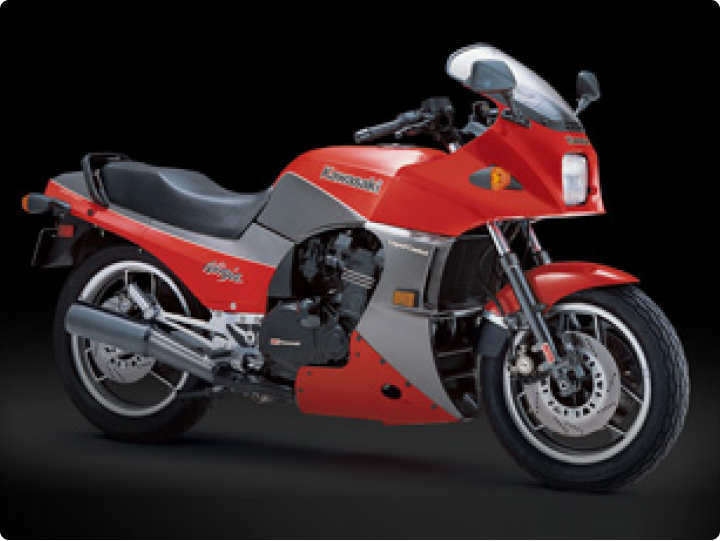
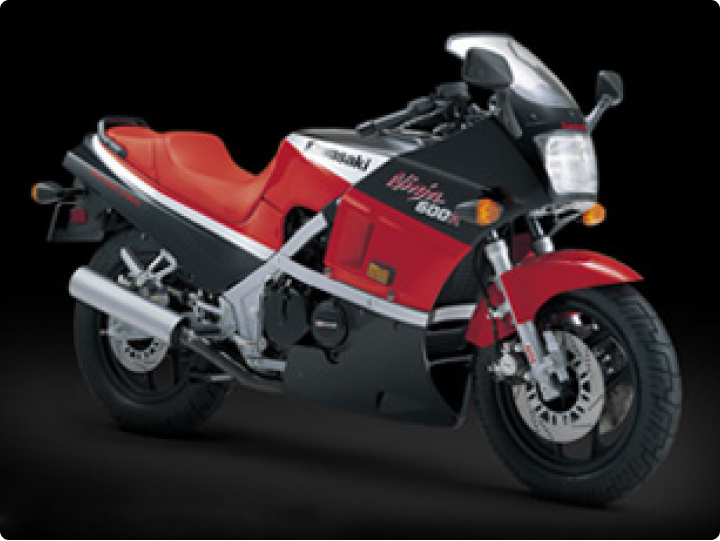
BIRTH OF
THE 600 CLASS
Excellent brakes and suspension and an original design make the Ninja 600R extremely popular; it becomes a best seller as soon as its sales commence.
Kawasaki’s unique sports bike philosophy, evidenced by the modern design of its newly developed perimeter-style frame, sets the new machine apart from competing models. As the first middleweight to offer engine, chassis and aerodynamic performance levels to rival larger-displacement bikes, the Ninja 600R is often credited with the creation of the 600cc supersport class.
Perfomance King
The Ninja ZX-10 is powered by a newly designed 997 cm3 engine. This potent power unit is mounted in an ultra-rigid aluminium e-BOX frame developed with feedback from Kawasaki’s works racers. With a light weight of 225 kg, it has a phenomenal top speed, ensuring Kawasaki’s continued reputation as a manufacturer of high-performance machines.
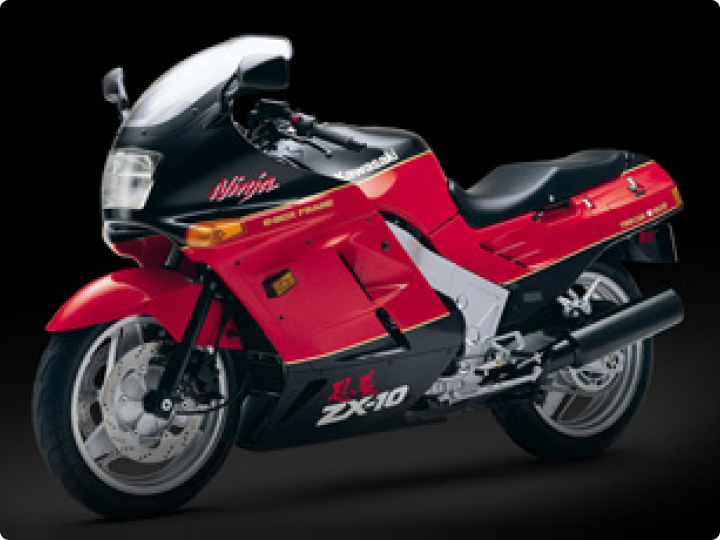

Works Racer DNA
In the debut year of the new ZXR series, the top model ZXR750 is christened 'Ninja' in the North American market. Not only is the Ninja ZX-7’s styling straight from the ZXR-7 works racer, its liquid-cooled, DOHC 16-valve In-Line Four engine, twin-tube aluminium frame and basic layout were also almost the same as the ZXR-7’s. Its incredible performance sets new standards for 750cc class machines.
First Ram Air System
Hits the Market
To boost engine output, Kawasaki mounts an air intake duct at the front of the fairing to force-feed air directly to the airbox. This is the industry’s first application of a 'Ram Air System' on a production motorcycle and gives the Ninja ZX-11 an unbelievable maximum power.
This 'monster bike' also features the first speedometer with a 320 km/h dial. The combination of huge horsepower and sophisticated aerodynamics make it the world’s undisputed “King of Speed” for the next six years. This model gives birth to the 'flagship' category.
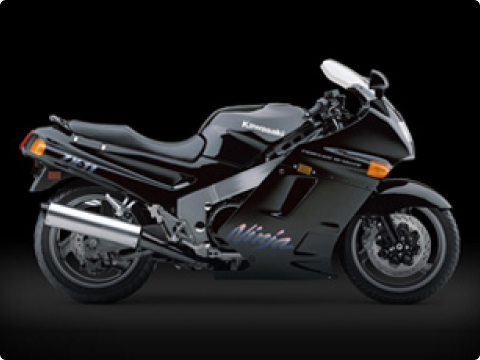
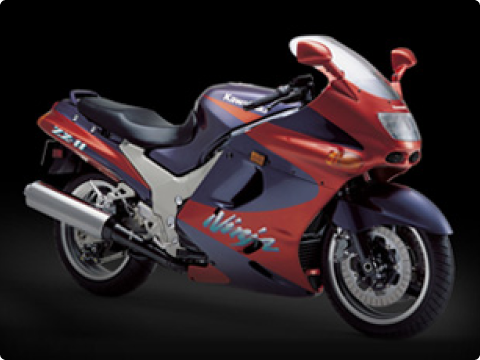
Technology Upgrades
for the Flagship
To ensure its position as the world’s dominant production motorcycle, the Ninja ZX-11 gets a major model change. Upgrades include Dual Ram Air Induction, a lighter aluminium perimeter frame and larger-diameter front disc brakes. The new model continues its predecessor’s reign as the world’s fastest production motorcycle.
Big-Bore Supersport
Featuring an engine heavily influenced by the ZXR750, but with more displacement, twin Ram Air intake and an aluminium frame, the radically new Ninja ZX-9R offers an unparalleled balance of size, power and rider-responsive handling.
Taking high performance to an entirely new level, this 900cc supersport model sets the standards for others to follow.
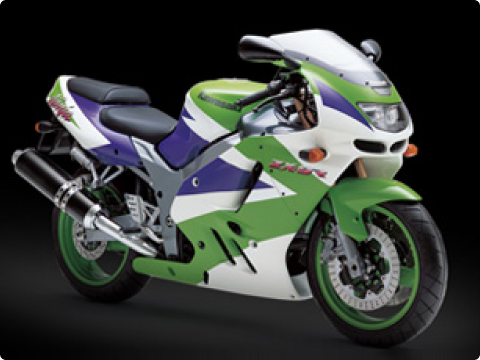
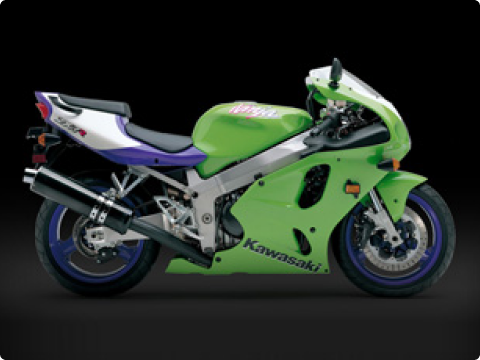
Race Developed Performance
Replacing the championship-winning Ninja ZX-7/7R (ZXR750/R), the new Ninja ZX-7R and limited edition 7RR feature shorter-stroke engines and new aluminium perimeter frames. A limited-production racing homologation model, compared to the 7R the 7RR features variable rake, an adjustable swingarm pivot, a shorter wheelbase, and a racing seat. Winning races around the world, it firmly establishes the Ninja’s reputation for high performance.
Uncompromising Performance
The all-new Ninja ZX-9R shatters the status quo. Smaller, lighter and more powerful, it features a compact new engine with Kawasaki Throttle Responsive Ignition Control (K-TRIC), “stick-type” plug-mounted ignition coils, magnesium engine covers and a titanium muffler. A shorter, lighter chassis uses the engine as a stressed member allowing the twin down tubes to be eliminated for high compactness.
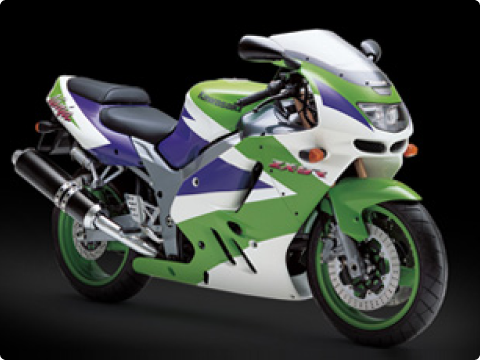
New Millennium Flagship
The flagship model of Kawasaki’s supersport Ninja Series. Intended to be the successor to the King of Speed throne, the Ninja ZX-12R features the first mass-produced aluminium monocoque frame, an advanced technology liquid-cooled DOHC 16-valve In-Line Four engine with a lofty maximum power, an aerodynamically crafted chassis and numerous other unique features.


Rebirth of
the Supersport Middleweight Class
Sales of Ninja ZX-6R (636 cm3) and the Ninja ZX-6RR (600 cm3) commence. Designed to be the quickest circuit bikes in their class, these completely redesigned Sixes are the first production bikes to feature radial-mount brake calipers and other components usually found only on race machines. The Ninja ZX-6R was developed with street riders in mind while the ZX-6RR was built for racing.
Circuit Domination
Introduced to the world’s press on the 20th anniversary of the original Ninja (GPz900R), Kawasaki’s new litre-class supersport model is designed for one purpose: total domination on the racetrack.
Boasting a sizeable engine output and weighing in at a mere 170 kg, the Ninja ZX-10R has a remarkable power-to-weight ratio. Incredible performance and racer-friendly characteristics make it the winner of supersport shootouts around the world and earn it the title of Master Bike two years in a row.


Faster, Smoother, Quicker
Once again the Ninja ZX-6R (636 cm3) and ZX-6RR (600 cm3) rock the 600 class. A more powerful engine is complemented by elegantly curved bodywork and an under-seat muffler for improved aerodynamics and enhanced high-speed performance.
The race-bred chassis is thoroughly refined and delivers superb handling. For 2005 the 6R also gets the slipper clutch used on the race-focused 6RR. These upgrades make these new Ninjas the most potent middleweights on the circuit and on winding roads.
Legend Reborn
Kawasaki fans rejoice at the arrival of the Ninja ZX-14. Featuring Kawasaki’s most powerful engine ever and an all-new aluminium monocoque chassis wrapped in sculpted bodywork both aerodynamic and awe-inspiring, the new flagship is a showcase of the latest technology and Kawasaki craftsmanship.
Designed to deliver the ultimate supersport riding experience, the Ninja ZX-14’s superb balance of performance, handling and a virtually palpable presence recalls the legendary machines whose spirit it embodies.


More Race-Winning Potential
For 2006 the Ninja ZX-10R benefits from comprehensive refinements that further enhance its racetrack performance. A new aerodynamic package includes a new fairing and bodywork and twin under-seat mufflers. Designed to help riders trim their lap times, the new 10R features the same awesome power, superior cornering performance and an all-new aerodynamics package.
Less obvious upgrades include revised chassis geometry and the fitment of an Öhlins steering damper. All these improvements have one goal in mind: quicker lap times. Amazingly, the new engine meets the stringent Euro 3 standards with no loss of maximum power.
The Ninja Family
Gets A New Member
With the debut of Ninja 650R the Ninja family gets a new member. Powered by a responsive Parallel Twin engine mounted in a lightweight chassis and featuring sleek, sophisticated styling, this rider-friendly Ninja appeals to both new riders and veterans alike.


A Fusion of 'R' & 'RR'
An all-new Ninja ZX-6R (600 cm3) debuts. Two things make this new Six particularly special. The first is that it replaces two models: both the best-selling 636 cm3 Ninja ZX-6R and the limited-edition 599 cm3 Ninja ZX-6RR. The second is that it is new from the cases up – for the first time in 10 years.
An ultra-compact yet powerful engine, incredible mass centralisation, a rider-responsive chassis and the cornering prowess of a lightweight small-displacement GP machine make this evolution of the Ninja ZX-6R the closest representation of Kawasaki’s ideal 600cc-class circuit machine to date.
Race-Bred High Performance
How the best get better: A new engine featuring dual injectors feeding oval sub-throttle bodies pumping out more high-rpm horsepower with no loss of low- and mid-range torque. Advanced electronic technology like KIMS (Kawasaki Ignition Management System) for precise power control. And a new frame and ergonomics delivering improved rider feedback.
This potent package of race-developed technologies makes the Ninja ZX-10R the winner in the international comparison test “Supertest” two years in a row.


Good Things Do Come in Small Packages
Designed for riders of all levels, the Ninja 250R offers an engine character that can be fully exploited, a compact, easy-to-ride chassis and numerous rider-friendly features – all wrapped in full-fairing supersport styling that would not be out of place on top-class Ninja supersport models.
Two versions are released: a carburetted model for N. America (replacing the long-time bestselling entry model of the same name), and a fuel-injected model for Europe. This 250cc class Ninja becomes an instant hit the world over.
Precise Control for Maximum Excitement
An evolution of the 2007 model, the new Ninja ZX-6R takes the track-focused performance of its predecessor to the next level. Reduced weight, chassis fine-tuning and mass centralisation result in a lighter-handling machine. The first production-use of Showa’s BPF (Big Piston Front fork), combined with the already potent triple petal disc brake package and highly effective slipper clutch, offer excellent control and superb composure under hard braking.
The updated engine offers a much stronger mid-range and very precise throttle control and feel at all rpm. Revised ergonomics complement the precise control offered by chassis and engine by providing a natural rider interface with a high level of feedback, inducing a high level of confidence that allows riders to go faster and enjoy themselves when pushing hard.


Sportier Looks & Performance
Comprehensive upgrades to engine and chassis make this middleweight Ninja even more fun and easier to ride. Designed for sporty street riding, the bike’s aggressive styling is just like that of the pure supersport Ninjas.
Evolution in The Name of Victory
Loaded with advanced electronic control technologies like S-KTRC, Kawasaki’s predictive traction-control system, variable power modes, and an ultra-precise ABS system (KIBS), the new track-focused Ninja ZX-10R mounts a more powerful engine in a 10 kg lighter chassis.
Designed to excel in superbike racing, overall performance is significantly enhanced. Wrapped in an aggressive new fairing, the more compact chassis delivers much more responsive handling qualities.


New-World Sports Bike With Real-World Versality
In addition to the high performance and aggressive Ninja styling of a supersport machine, the Ninja 1000 has a relaxing riding position, a 3-position adjustable windscreen and other rider-friendly features.
The liquid-cooled, 1,043 cm3, In-Line Four engine delivers instant throttle response and impressive low- and mid-range acceleration. An aluminum twin-tube frame offers both superb stability and rider-responsive handling.
All-Round Twin-Cylinder Fun-Bike
The lightweight Ninja 400 is powered by a gutsy twin-cylinder engine and features a sporty full fairing. Whether cruising at speed on the highway or zipping around town, this all-rounder is a blast to ride. Its sharp under-engine muffler contributes to a low centre of gravity and improved mass centralisation, while the offset laydown rear suspension and triple disc brakes deliver a smooth ride and impressive stopping power.


Kawasaki's Flagship
The result of continuous development from the original Ninja (GPz900R) onwards, the Ninja ZX-14R exemplifies the intense excitement and surprising versatility of the Ninja brand. A displacement increase to 1,441 cm3, making it the largest-displacement model in the series, delivers astonishing acceleration.
This awesome power is controlled by the KTRC 3-mode traction-control system and selectable power modes for amazing sport-riding or relaxed high-speed cruising. Never before has so much power been so civilized and so much fun.
Sportier And More Rider-Friendlyy
A further development of the Ninja 650R concept, this middleweight all-rounder is powered by a 649 cm3 Parallel Twin engine specially tuned for high torque output in the most commonly used rpm range. A new double-pipe frame enables a slimmer shape, and a backbone style sub-frame makes it easier for the rider’s feet to reach the ground, making sporty riding on the Ninja 650 even more accessible than ever.


A Wider Range of Riding Excitement
Capitalising on the highly successful racing performance of its predecessor, the new Ninja ZX-6R expands its area of expertise beyond the racetrack. The engine has been bumped up from 599 cm3 to 636 cm3 for more torque, more excitement and even sportier performance on the street.
The race-bred chassis features the first use of the advanced SFF-BP fork on a production machine. 3-mode KTRC, KIBS and other advanced electronic control technologies make this Ninja equally dominant on the track, on the street or in the twisties.
Sportbikes With
High Quality Beyond Their Class
A successor to the highly popular Ninja 250R, a model much loved around the world, the new Ninja 300 features a displacement boosted to 296 cm3 for even more exciting performance. Its more powerful engine features an assist & slipper clutch and is mounted in a newly designed high-tensile steel frame. A wide 140 mm rear tire ensures superb road-holding and great handling. The low, aggressive design is pure Ninja and boasts eye-catching dual headlights, just like the Ninja ZX-6R. A 249 cm3 version, the Ninja 250, is also available depending on the market.


A Ninja Like No Other
A combination of supersport handling performance, all-round utility and high comfort make the Ninja 1000 a one-of-a-kind motorcycle. Extensive changes to the 2014 model result in more direct response from both engine and chassis. Other improvements include 3-mode KTRC, selectable power modes and other advanced technologies. Perfectly integrated, quick-detach side luggage (optional) offers more functional touring and town use.
The Perfect Balance
Between Sport & Comfort
Carving twisties on the weekends or riding to school or work in town, the middleweight Ninja 400 does it all in style. Its Parallel Twin engine has been upgraded for more power at all rpm, and a newly designed double-pipe frame is more compact for superb handling. And it looks as good as it goes, thanks to a new, more aggressive design. Comfort is improved thanks to a new seat and adjustable windscreen. This is a bike that everyone from new riders to experts will love.


Lightweight, Single-Cylinder Ninja
Mounting a liquid-cooled 249 cm3 single-cylinder engine in narrow, ultra-lightweight trellis frame made of high-tensile steel, the newest addition to the Ninja family delivers high-revving performance and nimble handling that is best-in-class. The forward-leaning riding position and aggressive full fairing make this lightweight Ninja a true supersport single. The Ninja 250SL creates a new paradigm for riding fun in the 250 class.
THE Birth of
H2 & H2R
The Ninja H2 is released alongside the Ninja H2R. Like the closed-course H2R, the street-legal Ninja H2 offers a sensory experience surpassing anything that riders can find. The two models feature more similarities than differences. The in-house designed supercharged engine features intake and exhaust systems compliant with street-use, but the highly efficient unit itself is the same but for model-specific cam profiles, head gaskets and ECU settings.
The chassis too features the same high-spec components as the Ninja H2R: a trellis frame with unique Swingarm Mounting Plate, top-of-the-line Brembo brake system, race-spec suspension, 5-spoke cast aluminium wheels, and an advanced electronics package (which even includes a Rain Mode not available on the Ninja H2R).
Its bodywork is noticeably different for having lights and turn signals, but its mirror stays incorporate airfoil cross-sections to ensure the necessary downforce generation for high-speed operation. And where the Ninja H2R uses a carbon-fibre upper cowl, that of the Ninja H2 is finished in Kawasaki’s original silver-mirror paint.


Built Beyond Belief
When the Ninja H2R is unveiled it generates considerable sensation, and at the press launch hardened motorcycle journalists are rendered virtually speechless by its phenomenal performance.
Born from a strong desire to offer riders something they had never before experienced, the “ultimate” motorcycle is developed from a clean slate. To realise the goal of delivering intense acceleration, an ultra-high top speed and supersport-level circuit performance, help is enlisted from other companies in the Kawasaki Heavy Industries (KHI) Group, precipitating an unprecedented level of inter-company collaboration.
Purposely developing the Ninja H2R as a closed-course model allows a pure pursuit of performance free of the limitations that street riding would impose. Its supercharged 998 cm3 In-Line Four engine, designed completely in-house, has an output that eclipses the power of normally aspirated counterparts while achieving a compact size on par with supersport litrebike-class units.
Advanced technological know-how shared from other group companies is also found throughout the innovative engine and chassis designs, most visibly in the aerodynamic bodywork, which features carbon-fibre upper and lower wings that add stability for riding in the ultra-high speed range.
The Kawasaki River Mark*1 is displayed prominently on the upper cowl, a testament to the inter-company collaboration and the level of resultant technology poured into this model.
*1 The Kawasaki River Mark is a long-time symbol of the KHI Group dating back to the 1870s. As a policy, its use on products is rare and limited to models with historical significance. But for the Ninja H2R permission to use this symbol is granted.
Superbike World Championship
In just his first year with the Kawasaki Racing Team, Jonathan Rea is virtually unstoppable on his way to taking the Superbike World Championship crown on his Ninja ZX-10R.
Starting the season with a 20-race podium streak, and winning 14 of the year’s 26 races allows him to accumulate a massive 548 points, just 4 points shy of a new record and 132 points more than the 2nd-placed rider. Together with teammate Tom Sykes (3rd in 2015), the KRT riders capture Kawasaki’s first-ever manufacturers’ title in the series.


The Closest Thing to
A Superbike World Champion Machine
Designed to be even faster on the track, this refined Ninja ZX-10R benefits from extensive feedback from the Kawasaki Racing Team. The 998 cm3 In-Line Four engine meets stricter emissions regulations while maintaining its heady top-end and offering a stronger mid-range for quicker corner exits.
A lighter crankshaft and revised chassis geometry result in lighter handling. The highly advanced Balance Free Front Fork developed with Showa in WSB is the first of its kind offered on a mass-production model. It is complemented by Showa’s BFRC lite (Balance Free Rear Cushion) at the rear.
A top-shelf Brembo front brake system (M50 monobloc calipers, 330 mm discs, radial-pump master cylinder, stainless-steel braided lines) delivers increased brake force, enhanced controllability and improved touch.
And the aerodynamic front cowl features a larger windscreen, offering riders greater wind protection to facilitate setting up for corner entry.
The new Ninja ZX-10R is also loaded with next-level electronics. A switch to electronic throttle valves enables the addition of new systems like KLCM (Kawasaki Launch Control Mode) and Kawasaki Engine Brake Control. A new Bosch IMU (Inertial Measurement Unit) complements Kawasaki’s proprietary dynamic modelling program to give the ECU an even more accurate real-time understanding of what the chassis is doing, and enabling systems like S-KTRC (now with 5 modes) and KIBS to make the transition to feedback-type systems for even more precise operation. A new cornering management function, KQS (Kawasaki Quick Shifter) and Power Modes round out the litrebike’s electronic suite
A pair of fine-tuned flagships arrive
The new Ninja ZX-14R (ZZR1400 in Europe) features revised engine tuning that meets stricter emissions regulations without compromising performance. A new “high-grade” version adds a number of prestige features, including a high-spec Brembo brake system, Öhlins rear suspension (on non-North American models), and detail changes that add a touch of class to the already impressive cockpit. Both versions offer a raised handlebar position for most Asian markets


